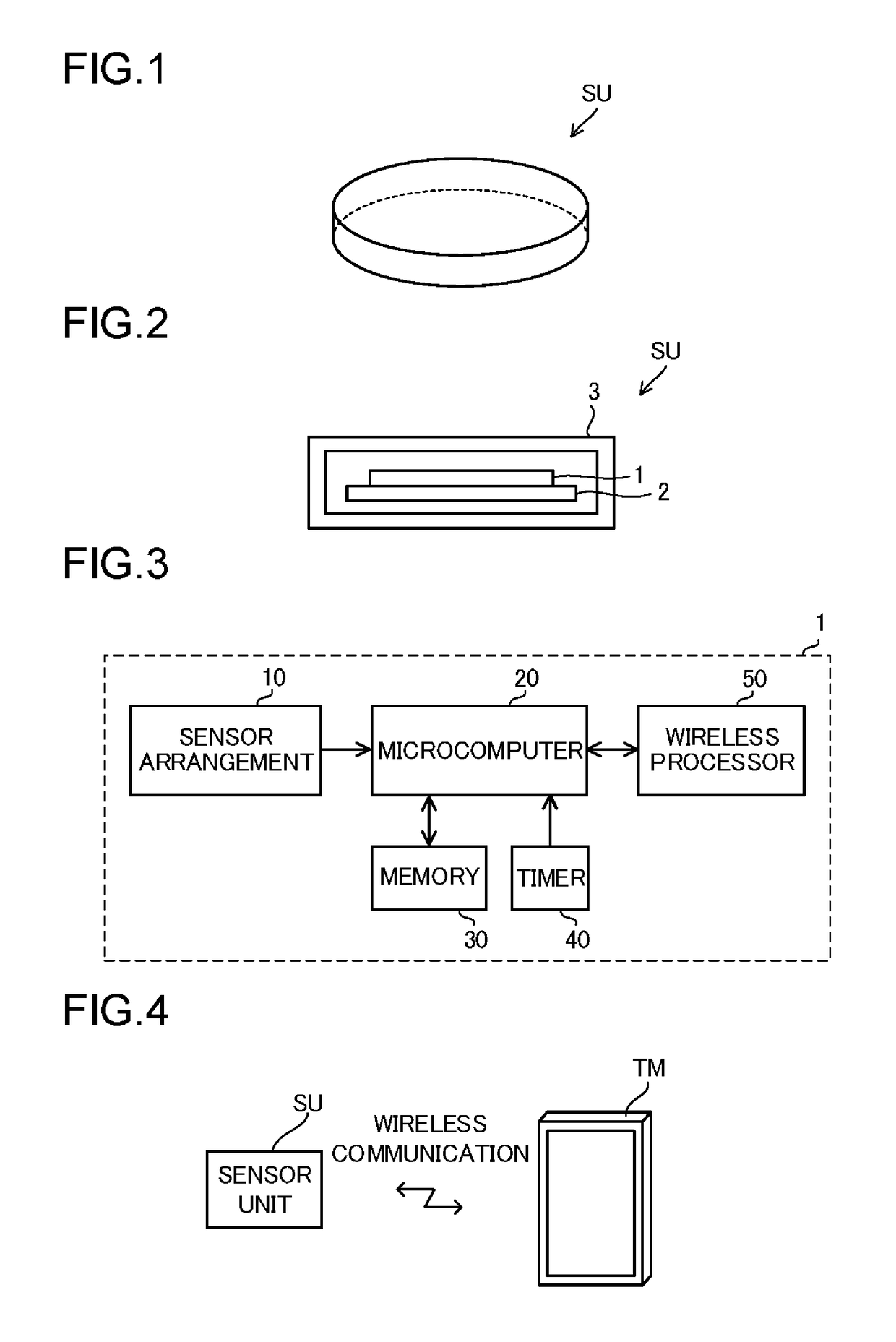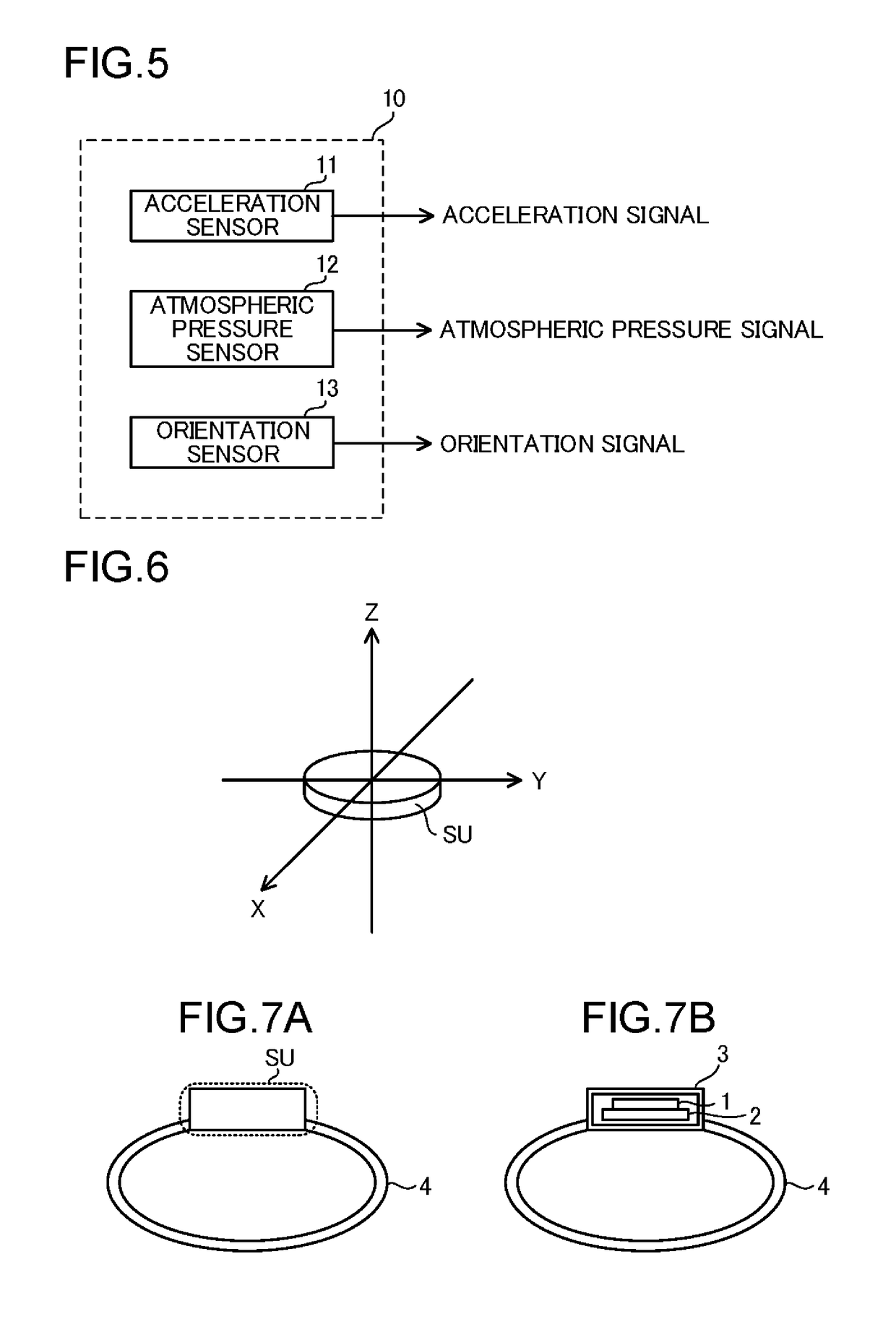Index deriving device, wearable device, and mobile device
a technology of index and index, applied in the field of index derivation devices, wearable devices, mobile devices, etc., can solve problems such as the subject's ability to stand up
- Summary
- Abstract
- Description
- Claims
- Application Information
AI Technical Summary
Benefits of technology
Problems solved by technology
Method used
Image
Examples
first embodiment
[0047]A first embodiment of the present invention will be described. FIG. 1 is an exterior perspective view of a sensor unit SU according to the first embodiment of the present invention. FIG. 2 is a schematic diagram showing the structure inside a housing 3 of the sensor unit SU. The sensor unit SU includes a component group 1, a circuit board 2, and a housing 3. On the circuit board 2, there are mounted electronic components that constitute the component group 1. The circuit board 2 having the component group 1 mounted on it is housed in and fastened to the housing 3, which is made of resin or metal and has a predetermined shape. The housing 3 has a cylindrical shape with a comparatively small thickness, so that the sensor unit SU has a shape like a medal; thus, the sensor unit SU can also be called a sensor medal. The housing 3 does not necessarily need to have a precisely cylindrical exterior shape; for example, a part corresponding to a base of the cylinder may be curved. The h...
second embodiment
[0055]A second embodiment of the present invention will be described. The second embodiment—and also a third and a fourth embodiment, which will be described later—is based on the first embodiment. Accordingly, as to such features of the second embodiment as are given no particular mention, the relevant description given for the first embodiment, unless inconsistent, applies equally to the second to fourth embodiments. As to such features of the second embodiment as contradict between the first and second embodiment, their description given for the second embodiment prevails (the same is true with the third and fourth embodiments described later). Unless inconsistent, two or more of the first to fourth embodiments can be implemented in combination.
[0056]The second embodiment deals with a method for measuring the muscular strength or the like of a subject by use of a measurement device including the sensor unit SU (the significance of muscular strength will be discussed later). A per...
third embodiment
[0119]A third embodiment of the present invention will be described.
[0120]The microcomputer 20 includes an activity amount deriver which measures and derives the amount of activity. The amount of activity denotes the amount of activity of the human body as a user (in other words, subject). To more accurately acquire acceleration occurring in every kind of physical activity of a user, it is preferable that the sensor unit SU be in as close contact as possible with the user's body.
[0121]The amount of activity is an index that indicates the amount of physical activity of a user as calculated and acquired by the sensor unit SU, and can be, for example, the amount of physical exertion (in the unit of exercise (EX)) defined as the intensity of physical exertion multiplied by the duration of physical exertion. The intensity of physical exertion is a quantity that indicates the intensity of a person's physical exertion in terms of multiples of that at rest, and is given in the unit of METs ...
PUM
 Login to View More
Login to View More Abstract
Description
Claims
Application Information
 Login to View More
Login to View More - R&D
- Intellectual Property
- Life Sciences
- Materials
- Tech Scout
- Unparalleled Data Quality
- Higher Quality Content
- 60% Fewer Hallucinations
Browse by: Latest US Patents, China's latest patents, Technical Efficacy Thesaurus, Application Domain, Technology Topic, Popular Technical Reports.
© 2025 PatSnap. All rights reserved.Legal|Privacy policy|Modern Slavery Act Transparency Statement|Sitemap|About US| Contact US: help@patsnap.com



